
Oscar-Claude Monet was a French painter and founder of impressionist painting who is seen as a key precursor to modernism, especially in his attempts to paint nature as he perceived it. During his long career, he was the most consistent and prolific practitioner of impressionism's philosophy of expressing one's perceptions before nature, especially as applied to plein air (outdoor) landscape painting. The term "Impressionism" is derived from the title of his painting Impression, soleil levant, exhibited in 1874 initiated by Monet and his associates as an alternative to the Salon.
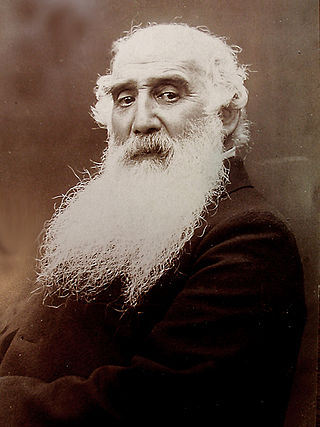
Jacob Abraham Camille Pissarro was a Danish-French Impressionist and Neo-Impressionist painter born on the island of St Thomas. His importance resides in his contributions to both Impressionism and Post-Impressionism. Pissarro studied from great forerunners, including Gustave Courbet and Jean-Baptiste-Camille Corot. He later studied and worked alongside Georges Seurat and Paul Signac when he took on the Neo-Impressionist style at the age of 54.

Maximilien Luce was a prolific French Neo-impressionist artist, known for his paintings, illustrations, engravings, and graphic art, and also for his anarchist activism. Starting as an engraver, he then concentrated on painting, first as an Impressionist, then as a Pointillist, and finally returning to Impressionism.

Neo-Impressionism is a term coined by French art critic Félix Fénéon in 1886 to describe an art movement founded by Georges Seurat. Seurat's most renowned masterpiece, A Sunday Afternoon on the Island of La Grande Jatte, marked the beginning of this movement when it first made its appearance at an exhibition of the Société des Artistes Indépendants in Paris. Around this time, the peak of France's modern era emerged and many painters were in search of new methods. Followers of Neo-Impressionism, in particular, were drawn to modern urban scenes as well as landscapes and seashores. Science-based interpretation of lines and colors influenced Neo-Impressionists' characterization of their own contemporary art. The Pointillist and Divisionist techniques are often mentioned in this context, because they were the dominant techniques in the beginning of the Neo-Impressionist movement.
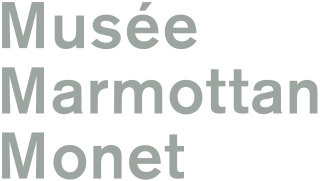
Musée Marmottan Monet is an art museum in Paris, France, dedicated to artist Claude Monet. The collection features over three hundred Impressionist and Post-Impressionist paintings by Claude Monet, including his 1872 Impression, Sunrise. The museum's fame is the result of a donation in 1966 by Michel Monet, Claude's second son and only heir.

Eugène Louis Lami was a French painter and lithographer. He was a painter of fashionable Paris during the period of the July Monarchy and the Second French Empire and also made history paintings and illustrations for books such as Gil Blas and Manon Lescaut.
The Impressionists is a 2006 three-part factual docudrama from the BBC, which reconstructs the origins of the Impressionist art movement. Based on archive letters, records and interviews from the time, the series records the lives of the artists who were to transform the art world.

Lucien Pissarro was a French landscape painter, printmaker, wood engraver, designer, and printer of fine books. His landscape paintings employ techniques of Impressionism and Neo-Impressionism, but he also exhibited with Les XX. Apart from his landscapes, he painted a few still lifes and family portraits. Until 1890 he worked in France, but thereafter was based in Great Britain. He was the oldest son of the French Impressionist painter Camille Pissarro and his wife Julie.
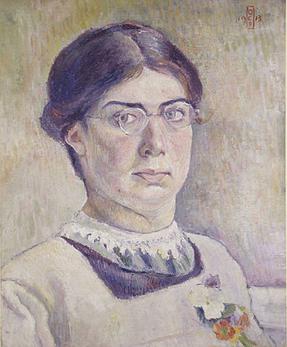
Orovida Pissarro, known for most of her life as Orovida, was a British painter and etcher. For most of her career she distanced herself from the Impressionist and Post-Impressionist styles of her father, Lucien Pissarro and grandfather, Camille Pissarro, in favour of a technique influenced by Chinese and other Asiatic art; but in the last quarter of her career developed a manner which drew on both traditions.

Boulevard Montmartre, Mardi Gras by Camille Pissarro currently resides in the permanent exhibition at the Armand Hammer Museum in Los Angeles, California. This work is part of a series of fourteen paintings depicting different times of the day and seasons of the Boulevard Montmartre in Paris. Camille Pissarro is known as the "Father of Impression" for his "teacher's eye" of drawing what he saw in front of him.

The House of the Deaf Woman and the Belfry at Eragny is an 1886 oil painting by French artist Camille Pissarro, located in the Indianapolis Museum of Art, which is in Indianapolis, Indiana. It is a view of Pissarro's neighbor's yard in Eragny, created during his brief period of experimentation with pointillism.

The Banks of the Oise near Pontoise is an 1873 oil painting by French artist Camille Pissarro, located in the Indianapolis Museum of Art, which is in Indianapolis, Indiana. It depicts the river Oise near the market town of Pontoise.
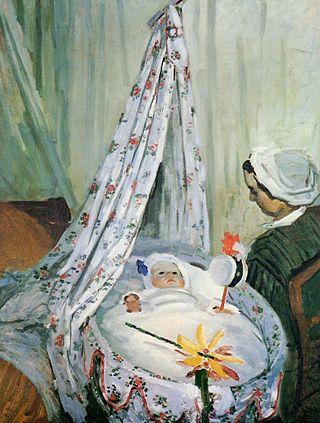
Jean Monet was the eldest son of French Impressionist artist Claude Monet and Camille Doncieux Monet and the brother of Michel Monet. He was the subject of several paintings by his father and married his step-sister, Blanche Hoschedé.

A Cowherd at Valhermeil, Auvers-sur-Oise is an 1874 painting by Danish-French artist Camille Pissarro. Done in oil on canvas, the work depicts the hamlet of Valhermeil in Auvers-sur-Oise, France, near Pontoise where Pissarro lived for several decades. The work, which is considered reflective of Pissarro's fascination and admiration for pastoral life, is in the collection of the Metropolitan Museum of Art.

Morning, An Overcast Day, Rouen is a late 19th-century painting by Danish-French artist Camille Pissarro. Done in oil on canvas, the work depicts the industrial cityscape of Rouen, France. The centerpiece of the painting is Boieldieu Bridge, a steel arch bridge which Pissarro painted from his room in a nearby hotel. The painting is in the collection of the Metropolitan Museum of Art.
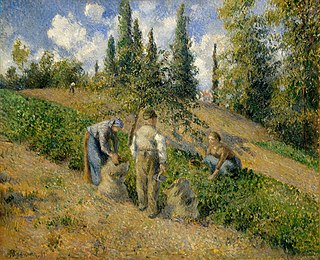
The Harvest, Pontoise is a late 19th-century painting by Dano-French artist Camille Pissarro. Done in oil on canvas, the work depicts a group of French farmers gathering potatoes; such subject material was a common theme used by Pissarro. The painting is in the collection of the Metropolitan Museum of Art.

Paul-Émile Pissarro, also Paulémile Pissarro or Paul Émile Pissarro was a French impressionist and neo-impressionist painter. He came from the Pissarro family of artists.
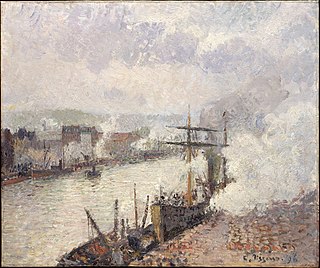
Steamboats in the Port of Rouen is a late 19th-century painting by Camille Pissarro. Done in oil on canvas, the painting depicts shipping in the port city of Rouen, France. Pissarro painted the work from his room in the Hôtel de Paris, which overlooked the one of the city's quays. The painting is similar to Pissarro's Morning, An Overcast Day, Rouen, and both works are in the collection of the Metropolitan Museum of Art.

Rue Saint-Honoré, dans l'après-midi. Effet de pluie is an 1897 oil painting by Camille Pissarro. The work was made towards the end of Pissarro's career, when he abandoned his experiments with Pointillism and returned to a looser Impressionist style. It is part of a series of works that Pissarro made in 1897-98 from a window of the Hôtel du Louvre, looking down across the edge of the place du Théâtre Français and along the rue Saint-Honoré, portraying the people, carriages and buildings, the trees, fountains and streetlamps, in an early afternoon shower of rain. Other paintings in the series depict a similar scene in morning sunlight, or in the shadows of the evening. The painting measures 81 cm × 65 cm.


















